Scenari vesuviani tra iconografia e letteratura dal Grand Tour
ITALIAN SCENERY, REPRESENTING THE MANNERS, CUSTOMS, AND AMUSEMENTS OF THE DIFFERENT STATES OF ITALY. BY JAMES GODBY, FROM ORIGINAL DRAWINGS BY P. VAN LERBERGHI; THE NARRATIVE BY M. BUONAIUTI
A cura
di
Aniello Langella
Un grazie ad Armando Polito per aver segnalato l’interessantissimo testo
La rappresentazione iconografica della letteratura europea nata sulla scia del Grand Tour, non poteva mancare nel “lessico descrittivo” inglese e francese. Un testo interessantissimo che vuole rappresentare con delle “istantaee” preziose ed anche originali, il contesto urbano, l’ambiente e la cultura stessa di una delle grandiose mete del “viaggio”. Frutto di bozze probabilmente monocrome, le stampe di questo testo vogliono cogliere non solo l’aspetto paesagistico, ma anche lo spirito di un popolo definito spesso indolente, ma che allo stesso tempo dimostrava operosità, intraprendenza e bellezza. Ci sorprendono i dettagli degli abiti, dei copricapo sia femminili che maschili.
THE LAZZARONI
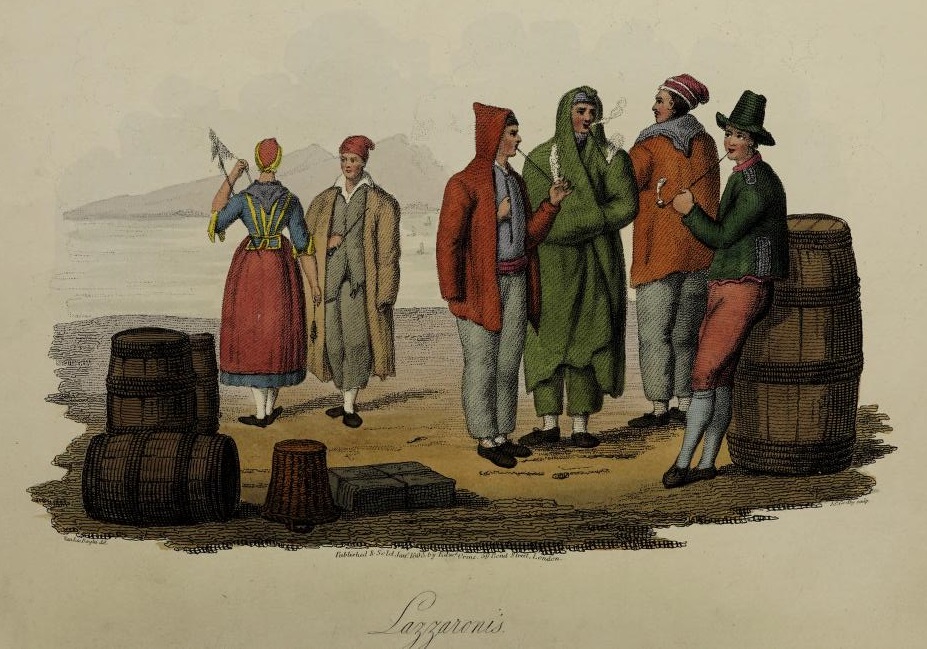
The Lazzaroni of Naples owe their appellation to Lazarus; and if they do not always appear like him in rags, their dress is never very splendid. They generally wear a red cap, a jacket of coarse cloth, with a conical hood, like that of the Neapolitan sailors, and a pair of large trowsers. On holidays they put on their best clothes, with silk handkerchiefs about their necks, and silver buckles in their shoes and at their knees. When the women of this class go out, either on business or for pleasure, they spin as they walk. The distaff is a stick fastened to their waist, by twisting it in their apron-string. The Lazzaroni have a Chief, called Capo Lazzaro, who receives much attention from the court and ministers. His office is something of the same nature as that of the Roman tribunes was formerly; for he takes care the people are respected, and no wrong done to them. He sometimes attends at court. Whenever the Queen is brought to bed, the Lazzaroni send a deputation to the palace, with their Chief at it’s head ; and if the infant prove to be of the sex they desire, he takes it in his arms, kisses it, and, coming out of the balcony of the King’s palace, shows it to his followers, addressing them in a suitable speech in his vulgar dialect, but in a truly eloquent style. He is present at the drawing of the lottery, at every extraordinary service performed in the church, and at the public galas at court, though without any particular mark of distinctions yet he is always respected, as he has constantly at his command between forty and forty-five thousand men; to which may be added the boatmen and fishermen of Chiaia, beside all the lowest class of the people. There never yet has been an example of one of these Chiefs receiving a bribe. The Lazzaroni have some laws peculiar to themselves; and they occasionally hold meetings, which government does not think it prudent to prevent. Their tribe and friends are so nu¬ merous, that it would be rash to provoke them. They aid the police in suppressing riots, when they take place without any provocation on the part of government. These very men in the last war, armed only with their knives, carried the French batteries near Gaeta. During a serious riot, their Chief becomes a very important person, as all his tribe look to’ him for orders. In such a case, the best step government can take is, to have recourse to some preacher, whom the Lazzaroni look upon as a saint; for he seldom fails to calm the fury of the people. The celebrated Father Mark has done wonders in this way during our own times.
LES LAZZARONI.
LES Lazzaroni de Naples tirent leurnom de Lazare, et s’ils ne se montrent pas toujours couverts, corame lui, de haillons, en general leur costume n’est jamais fort brillant. Leur habillement ordinaire consiste en un bonnet rouge, une jaquette d’ htoffe trhs-grossibre, avec un capuchon, comme celui des matelots, et une paire de pantalons tres-larges. Les jours de fete, ils mettent leurs plus beaux habits, avec des mouchoirs de soie pour cravate, et des boucles d’argent aux souliers et aux genoux. Lorsque leurs femmes sortent pour aller quelque part, ou pour se promener, elles filent toujours; meme en marchant. Leur quenouille est un simple b&ton fixe dans le ruban de leur tablier. Les Lazzaroni ont un Chef nomine Capo Lazzaro, pour qui la cour et les ministres ont beaucoup d’ egards. Sa fonction approche assez de celle des anciens tribuns de Rome, car il a soin de faire respecter le peuple, et d’empecher qu’on ne lui fasse aucun tort. Il y a de ceremonies de cour, oh ce Chef a sa place. Lorsque la Reine accouche, les Lazzaroni envoient, avec une deputation, leur Chef, qui prend l’enfant dans ses bras, lorsqu’il est du sexe desire, le baise, sort sur le balcon du palais du Roi, et le montre au peuple, qu’il harangue dans son jargon, mais avec une veritable eloquence. II assiste au tirage de la loterie, quel ques ceremonies d’hglise, et a la cour dans les jours de gala, sans porter aucune marque distinctive; mais toujours respecte, attendu qu’il a a ses ordres de quarante a quarante-cinq mille hommes, aux quels se joignent encore les bateliers de Chiaia, et tout le bas peuple. II n’y a point d’exemple d’un de ces Chefs qui ait btb corrompu par de l’argent. Les Lazzaroni ont des loix particulieres: ils s’assemblent toutes les fois qu’ils en ont be- soin, et le gouvernement ne peut point les en emp&cher. Ils sont en si grand nombre, que ce seroit une folie de les provoquer. Ils aident meme la police dans les revoltes partielles, qui arrivent sans qu’il y ait de la faute du gouvernement. Ce furent eux, qui, armes de leurs couteaux, cmporterent les batteries Francoises prhs de Gahte, dans la derniere guerre. Dans les eineutes, leur Chef devient un personnage important autour de qui tout se range. La cour n’a alors d’autre ressource, que d’employer quelque predicateur aime des Lazzaroni, et en odeur de sainteth parmi eux. Ces predicateurs parviennent toujours a calmer leur fureur. De nos jours le celebre Padre Marco les faisoit trembler d’un coup d’oeil.
DANCE OF LAZZARONI CHILDREN
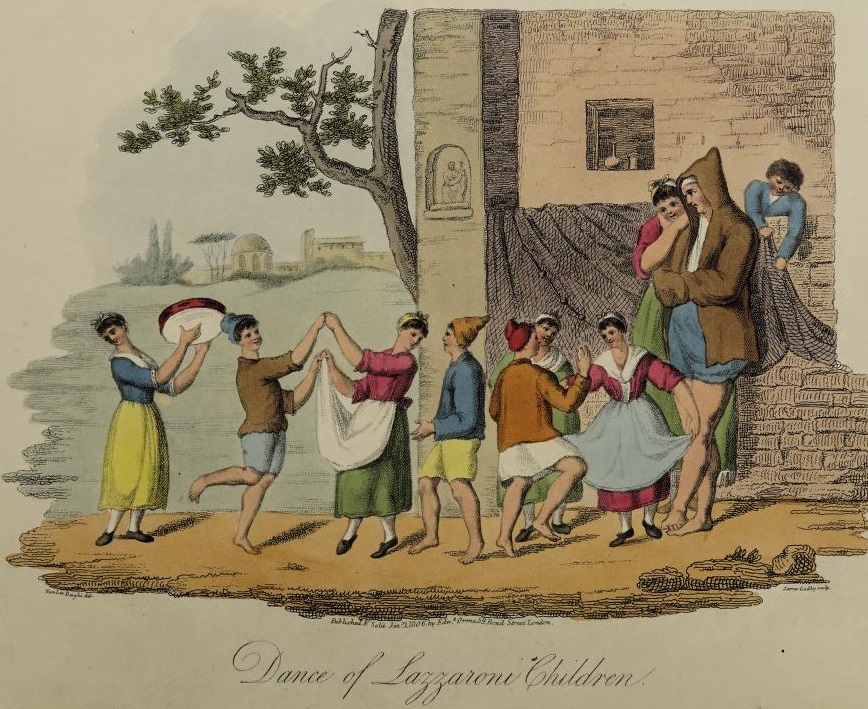
Family of Lazzaroni is here represented, where the father and mother are amusing themselves with observing several boys and girls dance. The fishing nets, spread upon the wall, show it to be the family of a fisherman. The children of this class at Naples have nothing to do but to amuse themselves, till the boys are grown strong enough to help their father in fishing, and the girls to assist their mother in domestic concerns. It is but seldom the parents think it necessary to send their children to school; perhaps never, unless an industrious father has had occasion to repent of his ignorance. In that case his son stands a chance of learning to read and write, that he may be preserved from a similar embarrassment. As to the girls, care is taken to keep them in ignorance, for fear their morals should be corrupted by reading: or, if the advantage of being able to read books of devotion ever happens to induce parents to have their daughters taught to read, they are seldom permitted to write, or read writing; lest they should employ their knowledge in sending or receiving love-letters. This is a strange and cruel prejudice, widely spread among the common people of Italy, but particularly in the country villages. The tambourine is the ordinary instrument that accompanies their dances, and is played upon exclusively by the women; who are thought to have received a genteel education, when they can play with skill most of the tunes of the different dances in use among them. This instrument is not a mere accompaniment in their hands, for they play the notes as distinctly as could be done on any other instrument.
The boys are dressed in linen or woollen cloth, generally very coarse, with breeches, or without; in the latter case, they wear a kind of short petticoat, not reaching quite to the knee. The girls are clothed in silk, ornamented with ribands or gold lace, according to the circumstances of their parents. This profusion of silk dresses and gold lace may appear astonishing, but they are very common from Tuscany to the South of Italy, especially among the lower people and peasantry; silk, though not the most durable, being the least expensive dress, and the gold or silver lace is showy, slight, and cheap. The Lazzarone appears by his dress to have just come ashore; being in the coarsest of his suits, and that most in use. The fishermen wear long trowsers, without stockings shoes; and when they have drawn their nets, and the boat touches the ground, they roll their trowsers up above the knee, jump into the water, and walk ashore.
On a represente ici une famille de Lazzaroni, avec le pfere et la mfere qui s’ amusent a voir danser de jeunes garcons et de jeunes filles. Les filets qui sont etendus sur la muraille font assez voir que ce sont des pecheurs. Les enfants de cette classe du peuple & Naples n’ont autre chose a faire qu’ a s’amuser conti- nuellement jusqu’ a Fage ofi ils sont assez forts pour travailler, les garcons a la peche, etles filles a aider leur mere dans le menage. II ne vient que rarement dans la tete des parents de leur faire apprendre a lire et a ecrire. Ce iFest que quand un pere industrieux a eu lieu de se repentir d’ &tre ignorant, qu’il envoie son fils a fecole, pour l’empecher de se trouver dans le meme embarras. Pour ce qui regarde les filles, on a bien soin de les laisser dans Fignorance afin que leurs mceurs ne se corrompent point par la lecture. Si l’avantage de pouvoir lire un livre de devotion persuade a leurs parents de leur faire apprendre a lire, on ne leur fait jamais apprendre a ecrire, ou a lirel’ecriture, pour qu’elles ne puissent pas ecrire ou lire de lettres d’amour. C’est un etrange et cruel prejuge assez repandu dans le bas peuple d’ Italie, et surtout dans les campagnes. Le tambourin est presque toujours Finstrument qui accompagne ces danses. Ce sont les femmes qui en jouent, et plus elles peuvent jouer d’airs differens, plus on juge quelles ont recu une education distinguee. Ce nest pas chezelles un instrument de simple accompagnement, car elles jouent superieurement bien la note.
Les garpons sont liabilles de toile, ou de drap de laine assez grossibre, avec des culottes ou sans en avoir, mais alors ils ontune espkce de jupon qui leur descend jusqifiami-cuisse. Les filles sont vetues de drap de soie, borde d’un reseau d’or, ou de rubans, suivant que leur famille est plus ou moins riche. On ne doit pas s’etonner de ce luxe, repandu depuis la Toscane jusqu” au midi de FItalie: si les habits de soie ne sont pas les plus durables, ils sont les plus dconomi- ques. Les reseaux d’or ou d’argent sont jfcu couteux, etant tres legers, et il y ayant d’or que ce que Fon peut voir. L’habillement du Lazzarone represente le costume de cette classe du peuple revenant de la peche. C’est l’habit le plus grossier et le plus use qufils aient. 11 a de longs pantalons a la matelote ; et, en retirant les filets a terre, lorsque la barque vient a toucher au rivage, ils les retroussent, et entrent ainsi dans l’eau pour achever leur travail, ou pour venir a terre.
NEAPOLITANS EATING MACARONI
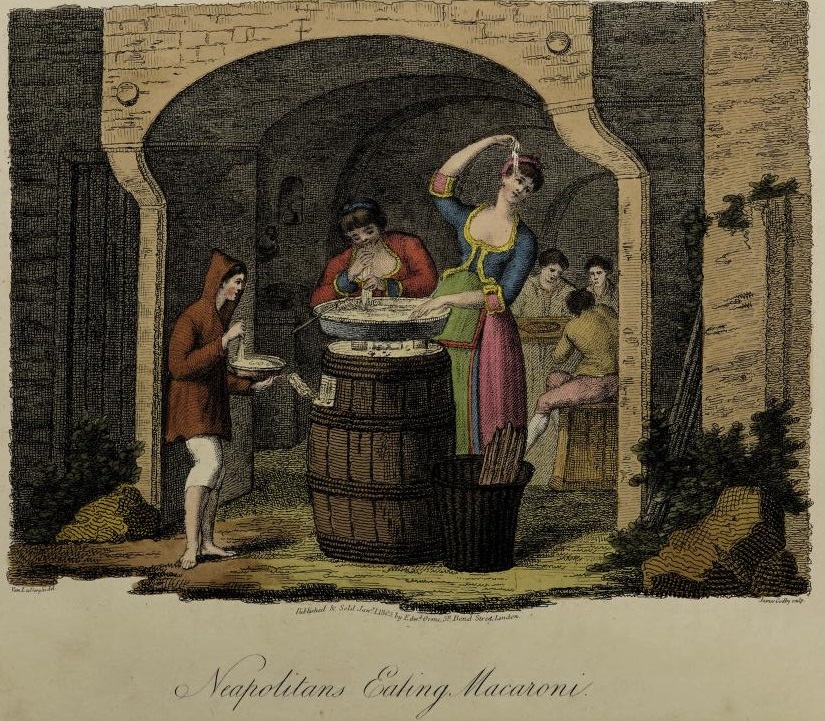
Naples and Genoa are the principal places, that furnish Italy with macaroni and vermicelli. The Neapolitan macaroni is generally preferred, being made from a species of corn called saragolla, the grain of which is very hard, and the bread made of it of a reddish colour and glutinous. The genuine semolina is made from this corn. It grows in Apulia, in Termini, in Sicily, and in Livadia. It degenerates near Rome, and much more in the north of Italy. The Neapolitan macaroni is easily known by not being twisted like that of Genoa, but straight, or bent only at one end; the reason of this is, that after having been forced out of the press to the usual length, it is cut off, and hung on a stick to dry. The hole of the pipe is very small, and this macaroni never breaks in cooking. It’s distinguishing character, however, arises from the quality of the grain, which is not to be found elsewhere, and which makes the paste appear reddish, granulous, and semitransparent, when held up to the light. If you break a piece the inside is shining, which is not the case with paste made of any other kind of corn. The plate represents a country maccaronava; for so are called those public houses where nothing but macaroni is sold; and no village is without them. It is extremely curious to see a common cask converted into a stove, as here. One of the ends is knocked out, and the vessel filled lightly with stones; a hole is cut in the side of the cask for the purpose of admitting the air; the materials for a fire are then laid on the top, and a complete stove is formed. The lower class of people in general eat the macaroni with their fingers, taking it out of the boiler with a wooden fork, and holding it high up with the right hand, in such a manner that the lower end just meets the mouth. Those who have not time to stay in the macccironara, takeoff their red caps, and depressing the upper part of them, put in the macaroni; which having paid for, they walk on, and eat as they go: when they have finished, they put on the cap again. Grated cheese and salt are all the ingredients required to be added to the macaroni: Parmesan is the favourite, but the common people make use of a cheese made of mare’s milk, called cacio cavallo, which is very palatable.
The Italians in general are very fond of maccaroni and vermicelli made into a soup ; but the Neapolitans cannot do without them. Punch, the clown of the Neapolitan stage, having been made a king, and macaroni being refused him, on account of it’s being too common a dish, says in his country dialect: “ mo mo me sprencepo,”—“ Then I will be a king no longer.”
C’est a Naples et a G6nes qne se font principalement les pates qui se mangent en Italic. On prefere les macaronis de Naples, car on les y fait d’une sorte de bled, ou saragolla, dont 1c grain est dur, et qui fait un pain rouge&tre et gluant. On le tire de la Pouille, de Termini, en Sicile, et de Livadie, en Grece; il degenere prhs de Rome, et encore bien davan- taoe au nord de l’ltalie. Le veritable semolino est fait de ce bled. On recommit les macaromills de Naples facilement: ils ne sont point entortilles, comrne ceux de Genes, mais ton! droits, et seulement crochus par un bout, car lorsque ils sont pousses hors de la presse ci la longueur ordinaire, on les suspend a des batons pour secher. Le tuyau qui les perce d’un bout a l’autre est trhs-petit, et tres-bien execute. Ils ne se cassent jamais en cuisant. Mais ce qui les caracterise le mieux, c’est que leur pate tire sur le rouge, qu’elle est granuleuse, et qu’en la regardant contre la lumiere, on y observe une transparence particuliere aux verita- bles macaronis de Naples, et qui depend de la qualite du grain. Si on les casse, Finterieur en est luisant; ce qui la pas lieu dans les pates faites avec toute autre expece de ble. La planche represente une maccaronara de campagne. C’est ainsi que Fon appelle a Naples une boutique oh Fon vend les macaronis. II y en a dans tous les villages. II est fort curieux de voir un tonneau change en pole. II est rempli de pierres, et vers le liaut on construit une espece de fourneau, par le moyen d’une ouverture pratiquee d’un cote du tonneau pour donner passage a Fair. Les gens du peuple mangent les macaronis ordinairement avec leurs mains, en les otant de la chaudiere avec une fourchette de bois, les prenantavec la main droite, et elevant le bras bien haut pour faire arriver le bas bout jusqu’ a la bouche. Les homines qui ne veulent pas s’ar- reter pour les manger, otent leur bonnet rouge, l’enfoncent un peu par le sommet, et en forment comme une 6cuelle, oil ils recoivent les macaronis, les paycnt et poursuivent leur chemin en les mangeant: aprhs, ils raccommodent leur bonnet, et leremettent tout uniment sur leur tet’e. On ne manque jamais de les saupoudrer de fromage. Le parmesan est le fromage favori, mais le bas peuple se contente de celui qu’on nomme cacio cavcillo, car on le fait de lait dejument, qui est fort appetissant. Les Italiens sont tres friands de macaronis; mais les Napolitains ne peuvent pas s’en passer. Polichinel, qui est l’Arlequin du theatre Napolitain, devenu roi, et a qui on ne donnoit pas de macaronis, parceque c’etoit un aliment trop commun, disoit en langage de son pays: “ mo mo me sprencepo,” “ dans le moment je vais quitter la royaute.”
Le immagini di personaggi scalzi, che mangiano con le mani, in una scenografia classicheggiante e policroma, affascinano il viaggiatore. Ciò non deve stupire nei primi dell’800, quando Napoli veramente era capitale europea, orgogliosa di mostrare sempre il suo lato ridente e colorito.
THE FISHMONGER
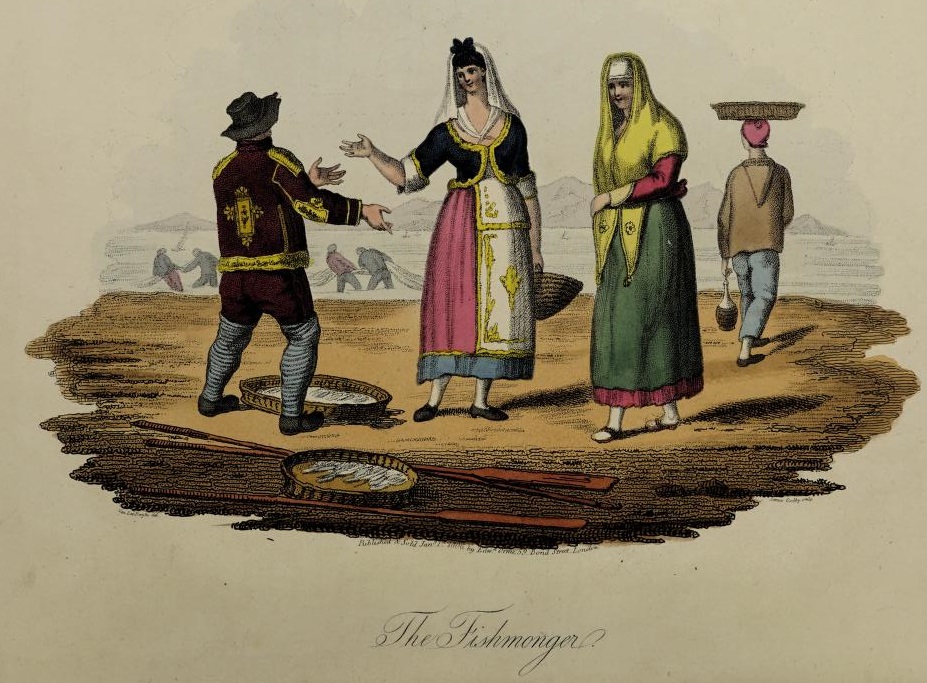
The sale of fish at Naples is a considerable branch of trade; by which many of the lower class of people, who have no other habitation for themselves and their family than their fishing boats, wholly subsist. The species of fish brought to market are in greater number than those offered for sale in England, where indeed little variety is to be seen. Foreigners are with reason surprised at this seeming scarcity, particularly so, as the British seas abound with the same species of fish as are seen in the markets abroad; but habit or prejudice makes the English look with suspicion or disgust upon many of them. Neapolitans on their arrival in this country, and landing at Plymouth, have found the same fish as at Naples; and on the rocks the same shell-fish; and having heartily feasted on them, have been pitied by the spectators, as hungry beings who would devour any thing. These are, however, equally as good as those in the bay of Naples; which are found to be a rich and constant source of trade,and are there in much request even with the English, who never suspect they have any thing like them at home.
The plate represents a man, who sells fish, making an agreement with a woman for the price. His gesticulations indicate the force of his argument, which is to prove that his merchandize is worth more than he demands for it; though he seldom fails to sell his fish for one third of the price he first set upon it. They talk very loud, as if they were quarrelling; but the Nea¬ politans are remarkable for their gesticulation, loud talking, and emphatic dialect. The dress of the man is extremely whimsical; being a brown jacket, ornamented with pieces of another colour, and flowers made of bits of cloth, cut to the shape of the flower intended to be represented, which is generally ideal. The women wear a short dress of velvet edged with gold or silver lace; an apron of cloth edged in the same manner; and a shawl of scarlet cloth bordered with green. Their hair is only gathered round or at the top of the head, and fastened with a riband. The present King of Naples not only amuses himself in fishing, but in selling the produc¬ tion of his fishery. His Majesty spreads his nets in that part of the bay, which is near mount Posilipo, at the distance of three or four miles from Naples. The market for sale is held on shore, and no credit is given. The buyers agree with the King himself for the price, who asks pretty high, for the purpose of being indulged with the abuse, which is dealt out to him as liberally as to any other fisherman. The annals of history cannot produce a king more popular than Ferdinand IV, nor has the French revolution any where found fewer partisans, than in the kingdom of the two Sicilies. Force only overpowered his subjects.
LE VENDEUR DE POISSON.
Le poisson est a Naples un grand objet de commerce, qui fait vivre beaucoup de gens dn bas peuple, qui ordinairement n’ont pour eux, et pour leur famille, d’autre habitation qne leur barques. Les especes dc poisson qu’on porte an marche sont bien en plus grand nombre, que celles que l’on voit vendre cn Angleterre, oh la variete est trhs bornee et qui les regardoient. Les etrangers s’etonnent avec d’autant plus de raison de cette disette apparente, que la mer de la Crande-Bretagne ne manque pas de ces memes especes de poisson qu’on voit dans les marches des pays etrangers, mais fhabitude ou le prejuge porte les Anglois a en regarder quel- ques-unes avec defiance ou degout. Des Napolitains venus de leur pays h Plymouth, ontre-r connu dans cette mer les memes poissons qu’a Naples, et sur les rochers les memes coquillages, et en ayant mange avec plaisir ont fait pitie a ceux qui les voyoient comme des gloutons aux- quels tout peut servir d’aliment. Cependant ces poissons sont aussi bons que ceux dela baie de Naples, ou ils sont une source riche et constante de commerce, et oh ils sont fort recher- clies par les Anglois eux-memes, qui sont bien loin de soupconner qu’ils en ont de semblables chez eux. Cette planche represente un vendeur de poisson, qui fait son marche avec une femme. Ses gcstes indiquent la force de ses arguments dont le but est de prouver que sa marchandise vaut plus qu’il n’en demande, quoiqu’il manque rarement de la vendre un tiers au-dessous. Ils parlent trhs haut, comme s’ils se querelloient: mais les Napolitains sont remarquables par leur gesticulation, par leur ton de voix elevh, et par femphase qu’ exige leur dialecte. L’habillement de l’homme est tres bizarre. C’est une jaquette d’une couleur brune, garnie et ornee de pieces d’une autre couleur, et avec des fleurs faites d’etoffe de differentes couleurs, coupee suivant le dessein de la fleur qu’on veut representer, mais qui est ordinairement imaginaire. Les femmes portent un casaquin de velours borde d’une dentelle en or ou en argent. Le tablierest de drap borde de meme; et les chales sont de drap d’ecarlate avec une bordure en vert. Leurs cheveux sont rassembles et assujetis sur la tete avec un simple ruban. Le Roi actuel de Naples s’amuse non seulement a la peche, mais encore a en vendre le produit. Il peche ordinairement dans cette partie de la baie qui est voisine du mont Pausi- lipe, a trois ou quatre milles de Naples, La vente s’en fait sur le rivage, et l’onne donnerien a credit. On marchande avec le Roi lui-meme, qui se plait a en exagerer le prix, pour jouir des sottises qu’on lui dit sans fapon, comme si e’etoit un marchand ordinaire. II n’est point fait mention dans l’liistoire d’un roi plus populaire que Ferdinand IV, la revolution Franpoise li’a trouve nulle part aussi peu de partisans que dans le royaume des deux Siciles. La force scale a triomphe.
Stupivano a Napoli le bancarelle del pesce, di qualità. Disposte lungo la Marinella che dal Maschio andava berso lo Sperone di Castel del Carmine. Stupiva il tipo di pesce, ma anche la ricchezza di quel mare che da sempre aveva fatto della pesca uno degli strumenti economici più audaci del Tirreno. L’immagine è enfatica e le venditrici di pesce vestono abiti insoliti; paiono quasi andalusi e poco vicini a quella che è l’iconografia coeva che ci viene da numerosissime immagini in stampa, su tele e su acqueforti.
A CALESSINO, OR HACKNEY-CHAISE
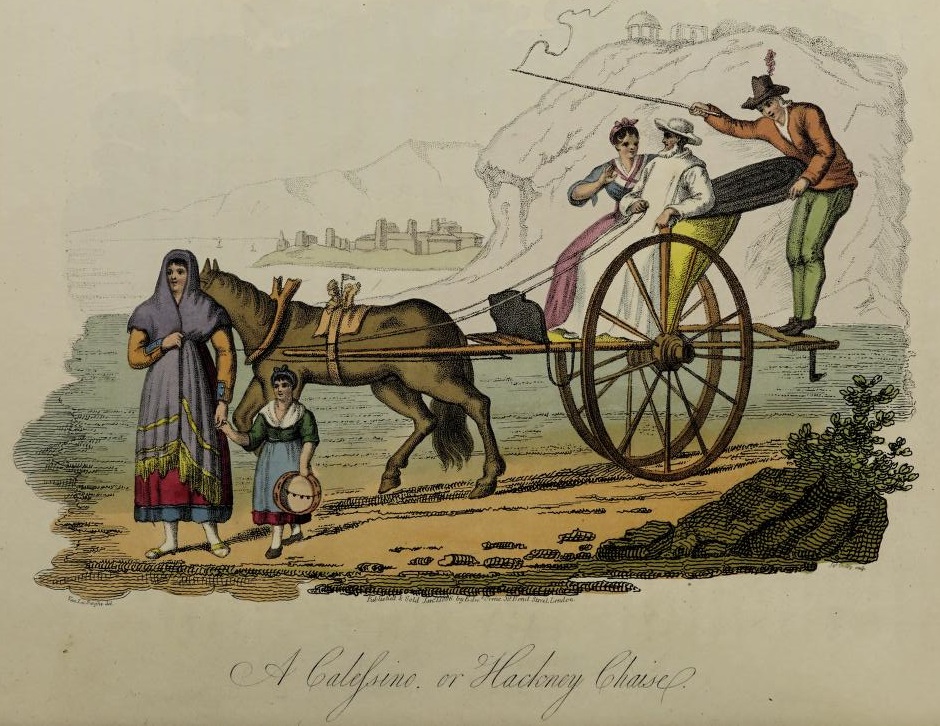
Hackney coaches in a town are certain evidences both of it’s extent, and of the industry of it’s inhabitants. The mere object of taking an airing would by no means employ any thing like the number of hackney coaches we see in London. It must be allowed, that a dis¬ tant visit will sometimes oblige us to make use of a coach; but commerce rather than pleasure multiplies and supports this kind of conveyance. Of all the cities in Italy there is no one, the buildings of which extend to so great a distance as those of Naples; and the Neapolitans are the busiest people among the Italians. They must then have felt the necessity of a quick communication from one place to another more than any other people of Italy : the latter of whom, indeed, either on account of the small¬ ness or form of their towns, or from the inactivity of their inhabitants, are not in absolute want of such conveyance. Milan is a large town, but it is almost square. Naples is oblong, and hence the necessity of the calessino, or hired carriage, as represented in this plate. As Naples is one of the best climates on earth, the calessino is generally without a covering, and calculated to carry two persons. The driver gives the reins to one of the persons within, who however makes no use of them. The coachman, standing behind, manages the horse by the application of his whip, but much more by his voice. He very seldom, and always against his will, gives the whole direction of the carriage to his passengers; as from the confusion of the principal streets, and the carriages going with great velocity, it would be extremely dangerous. When Bond Street is most crowded with carriages, it is nowise to be compared to the Toledo at Naples. The calessino is more or less ornamented, gilt, or adorned with basso relievoes in wood, according to the circumstances of the owner. On the back of the horse are some bells fastened to the harness, little flags, and other ornaments, depending on the fancy of the proprietor.
The landscape in the plate represents a view between Naples and Pozzuolo, which is the usual ride for pleasure with the calessino. The woman who is crossing the road wears a shawl of silk, embroidered and bordered .with fringe; which is generally the custom in the southern parts of Italy. The little girl has a tambourine, upon which the women of the country play very well, and which, with the exception of castanets, is the only instrument generally used at their dances.
LE CALESSINO.
Les fiacres dans un ville sont cles preuves certaines et de son etendue, et de findustrie de seslia- bitans. Le seal object d’aller prendre lair ne pourroit pas occuper un si grand nombrede fiacres qu’on en voit a Londres. On doit convenir qu’une visite eloignee nous engage quelquefois a prendre une voiture; inais le commerce plutot que le plaisir, est la cause qui entretient et multiplie le nombre de ces sortes de voitures. La ville de Naples est de toute Ittalie celle dont les batimens sont a une plus grande distance les uns des autres, et de tous les Italiens, les Napolitains sont les plus occupes. Us doivent done avoir senti la necessite d’une prompte communication d’un lieu un autre, plus que le reste des peuples de Ittalie qui n’ont pas ce besoin, soit a cause de la petitesse, ou de la forme de leurs villes, ou de l’inactivite de ses habitans. Milan est une grande ville, mais elle est presque carree: Naples est oblongue; et il y a de fiacres. Ce sont de calessini, ou petites caliches, tel qu’on en voit ici un represente. II est ordinairement decouvert, car Naples est dans le plus beau climat du monde. II ne peut contenir que deux personnes. Le coclier donne les renes a tenir a celui qui est dedans, qui pourtant n’en fait aucun usage. Le coclier, qui est monte derriere, guide le cheval avec son fouet, et beaucoup plus par sa voix. II en confie rarement, et toujours avec regret, l’entiere con- duite a celui qui y est assis; car la confusion qui regne dans les rues principales de Naples est si grande, et les voitures, et surtout ces cal&clies vont si vite, que le danger est toujours imminent. Lorsque Bond Street est le plus rempli de voitures, il ne peut en aucune manure etre compare a la rue de Tolede a Naples. La caRche est plus ou moins decoree, doree, et ornee de bas reliefs en bois, suivant que le maitre est plus ou moins riche. Sur le dos du cheval il y a toujours des ornemens fixhs sur les lmrnois, coniine des sonnettes, des grelots, et des banderoles, suivant la bizarreriedu proprietaire. Le fond du dessein represente la vue d’un paysage, qu’on trouve sur le chemin de Naples a Pouzzol, ce qui est la promenade ordinaire que l’on fait avec ces caleches. La femme qui traverse la route porte un espece de chale de soie brode, et garni de frange. Ces chales sont d’un usage general dans les parties les plus meridionales de Ittalie, La petite fille a un tambourin, dont toutes les femmes de la campagnejouent fort bien, et il n’y a guere d’autre instrument, si ce n’est les castagnettes, qui serve a leur dances champetres.
THE DANCE OF THE TARANTELLA
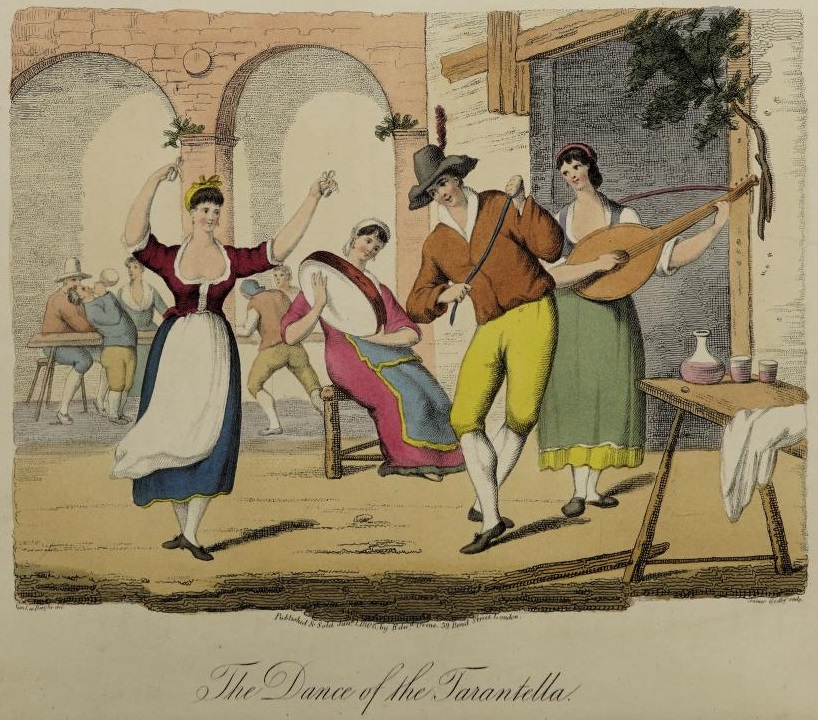
Most countries have a national dance, which is a favourite with the majority of the people; but it is generally confined to the lower class, for which reason, however, it is the more known, and the more celebrated. What the fandango is to the Spaniards, the tarantella is to the Neapolitans; and the seriousness of the former, and the vivacity of the latter, are admirably pourtrayed in the tunes of the two dances. We have already noticed the skill of the Neapolitan women on the tambourine ; but we see in the plate one playing on the guitar; and it is to be observed, that the Neapolitans are equally skilful on this instrument. The Spanish guitar is nearly twice the depth of the Neapolitan; and it is this alone that constitutes the difference between them. The instrument in the plate before us, however, is that species of guitar which is called the lute. It is a favourite instrument in Lower Italy; and is the sweetest in point of sound, as well as more extensive in compass. The woman is dancing with castanets, which at Naples are called castagnette, and in Tuscany nacchere. This instrument is a species of the ancient cymbalum, as the tambourin is of the tympanum, which in some medals is one of the attributes of Ceres. The man who is dancing holds a riband in his hand, and with it forms a variety of attitudes, which are at once whimsical and entertaining.
At the commencement of the dance the man and woman are stationed opposite each other: they advance, retire, change places, and look passionately at each other, with movements and gestures full of expression. The position of the feet is generally as here represented, only that the right and the left are alternately brought foremost; and sometimes the dancers show their skill by dancing either on their toes or heels. It is not certain whether the appellation of tarantella, given to this dance, come from the territory of Taranto, or from the spider called tarantola, many of which are there found, and the bite of which has been said to be mortal, unless cured by dancing to a brisk tune, like that appropriated to this dance. The Avonderful effects of the venom of this spider are so improbable, that, though formerly an article of common belief, both the disease and cure are iioav generally discredited. This dance, however, has been so much spoken of, that Ave have thought proper to annex the tune.
LA DANSE DE LA TARANTELLA
Presque tons les pays ont une danse nationale qui est aimee du plus grand nombre des- habitans, mais quien general est reservee au bas p£uple, ce qui fait quelle est plus connue et plus celebre. Ce que le fandango est pour les Espagnols, la tarantella l’est pour les Napolitains. Lair grave des premiers, et la vivacite des seconds, sont trbs-bien designees par la musique de ces deux danses. Nous avons deja parlé de l’adresse des femmes Napolitaines a jouer du tambourin, Comme l’on en voit ici une autre qui joue de la guitare, il est bon de remarquer que les Napolitains sont de fameux joueurs de guitare. Les guitares de Naples ont presque la moitie moins d’epaisseur que celles d’ Espagne, quoique de la m6me forme, ce qui leur a acquis le nom de guitare Espagnole et de guitare Napolitaine. Cependant l’instrument qu’on voit dans la gravure n’a nullement la forme d’une guitare, mais celle d’un luth, qui est aussi un instrument favori dans la Basse Italic, et qui a beaucoup plus de tons, et bien plus agreables que ceux de la guitare. La femme qui danse joue des castagnettes, que les Toscans appellent nacchere. Cet instrument n’est qu’un diminutif du cymbalum des anciens, comme le tambourin est le tympanum, qui dans des anciennes medailles est un des attributs de Ceres. Le danseur tient un ruban par les deux bouts, et pendant qu’il danse, il prend differentes attitudes tres comiques avec ses bras, sans jamais laisser tomber le ruban. En commencant cette danse, fhomme et la femme se placent vis-a-vis Tun de l’autre, ils s’approchent, ils se retirent, ils s’ecartent d’un cote, ils se poursuivent, sans s’atteindre, et se regardent toujours en s’agacant avec beaucoup d’expression. La position des pieds de fhomme et de la femme que l’on voit ici est toujours la meme si ce n’est que le pied change. Ils ajoutent par fois des tours de force, comme de marcher ou danser sur la pointe des pieds, on sur les talons. On ne sait pas bien si le nom de tarantella lui vient de Taranto, oh l’on voit beaucoup de ces grosses araignees appellees tarantola, ou si elle prend ce Mim de l’insecte m6me dont on dit que la morsure est mortelle, et se guerit en faisant danser le malade sur une musique d’un mouvement tres-vite, comme Test celui de cette danse. Mais la maladie aussi bien que le remede sont h present reconnus pour des erreurs populaires, quoique l’insecte existe. Cette danse est si celebre qu’on ajuge a propos de joindre ici fair de la Tarantella.
PLAYING AT THE RING
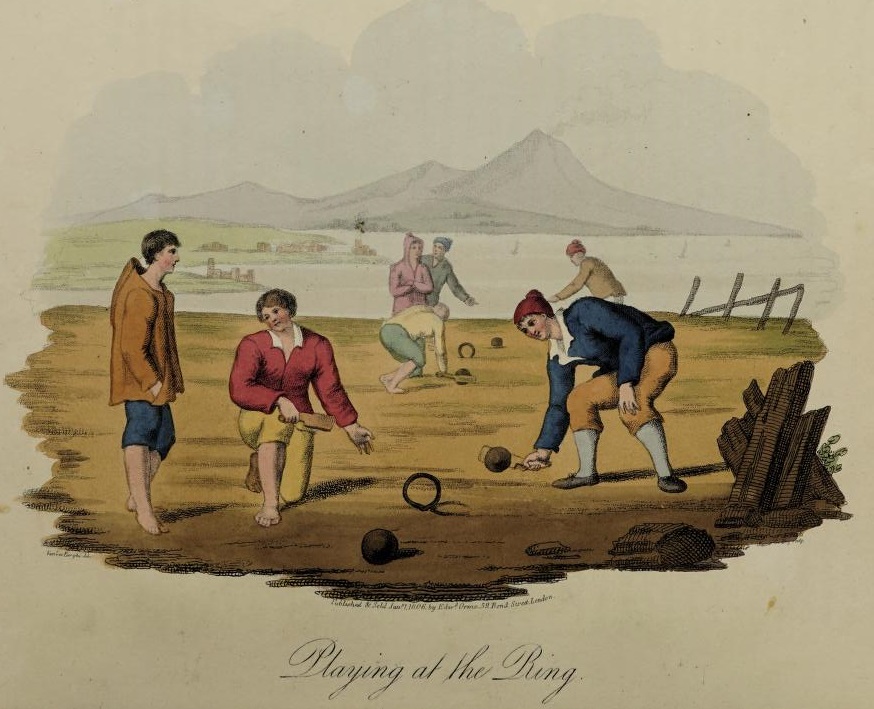
The youth of Italy, averse to every thing of a sedentary nature, are most amused with sports where considerable agility is required. This indeed is common to the youth of every country; but in Italy they are considered as a part of education, and as seriously enforced, as were formerly athletic exercises, being esteemed conducive to health and strength. At a very early age the game of fives in the open air begins to occupy them; and this is continued, from the fineness of the climate, for at least nine months in the twelve. When they are more advanced in years and growth, the balloon, or large leathern ball, filled with air, succeeds fives; and in towns where there is a court kept on purpose for this game, and where skilful players are hired, it is considered as the most amusing entertainment for after¬ noons, and the public resort to it as to a theatre, paying for their admission. The late carl of Pembroke endeavoured to introduce this amusement into England, and sent for the faous Taccaio from Florence. This man was a maker of leather balloons himself, and one of the first players of his time. A court was accordingly laid out at Pimlico; but the summer of that year proved so stormy, that they could not play more than eight times: whence it was concluded, that such a game was unfit for the climate of England. Italy provides also many other pastimes for it’s youth; some confined indeed solely to the lower class, such as playing at the ring. Two persons in general are the players, each of whom is provided with a wooden ball and a small bat. The ring is fixed to the ground, and the art consists in striking the ball with the bat, so as to drive it through the ring, and make it hit the ball of the antagonist. This game is very much in vogue at Rome and Naples. There is a variety of this game; in which the ring is made to turn on the iron fixed in the ground, in the same manner as we spin a piece of money on a table with the fingers. The proper time must then be watched, and the ball passed through the ring before it stops. The ragged appearance of the young players reminds us of an occurrence, that frequently happens to them. As they seldom have any money, and never much, the boys frequently agree to play for the metal buttons they have about them, which having lost, and sometimes to the very last, they never fail to receive a severe flogging when they go home. If it happen, that they win them back, previous to their going home they apply to some charitable woman in the neighbourhood to have them sown on again.
LE JEU DE L’ANNEAU.
Les jeunes gens d’ltalie, ennemis de tout espece de jeux sedentaires, ne s’exercent qu’a ceux oh. il faut de Fagilite. A la verite cette inclination leur estcommune avec la jeunesse de tous les pays; mais en Italic, ces jeux font partie de l’education, et sont aussi serieusement encourages que les jeux atliletiques l’etoient autrefois, dans la persuasion ou l’on est qu’ils contribuent a donner de la sante et de la force. Des l’enfance, la longue paume est Inoccupation des gallons, et, a cause de la beaute du climat, ils s’y livrent neuf mois de l’annee sur douze. Quand ils sont plus ages et plus grands, ils aiment a jouer au ballon; etdans les villes, ou il y a un enclos pour ce jeu, et que des entrepreneurs y appellent de toutes parts les meilleurs joueurs, le jeu du ballon devient un spectacle tres amusant, pour l’apres midi, ou l’on se rend, comme au theatre, et ou l’on paye en entrant. Feu Lord Pembroke tacha d’introduire ce jeu en Angleterre, et fit venir de Florence le fameux Taccaio, qui faisoit les ballons de cuir luimeme, et qui etoit a la fois un des meilleurs joueurs de son temps. On fit un enclos a Pimlico; mais Fete fut si orageux qifon put a peine jouer huit fois ; ainsi Fon fut convaincu que ce ifetoit pas un jeu pour ce climat. Il y a en Italie quantite d’autres jeux pour la jeunesse ; et plusieurs aussi qui ne sont que pour le bas peuple. Tel est le jeu de Fanneau. On le joue a deux, comme Fon voit ici; et cliacun des joueurs est pourvu d’une boule de bois, et d’une palette. L’anneau de fer est fixe en terre, et toute l’adrcsse consiste a pousser sa boule par le moyen de la palette, de manihre qu’elle passe par Fanneau et aille toucher celle deson adversaire. Ce jeu est tres k la mode parmi la populace de Rome et de Naples. On y joue aussi d’une autre manihre; et c’estquand Fanneau est passe dans un clou fixe en terre, et qu’on peut le faire tourner comme Fon fait tourner un ecu sur une table avec les doigts ; alors Fon doit prendre bien son temps pour faire passer la boule avant que Fanneau ait tout a fait cesse de tourner. Les guenilles dont sont couverts ces joueurs me rapellent ce qui leur arrive bien souvent. Comme ils ont rarement de l’argent, et jamais beaucoup, ces garpons convienhent de jouer les boutons de metal qu’ils ont a leurs habits, et les ayant perdus, quelquefois jusqu’au dernier, lorsque ils rentrent cliez eux ils sont rudement fouettes pour ccla. S’il leur arrive de les regagner, ils vont chez une voisine charitable pour les faire recoudre avant que de rentrer chez eux.
THE WASHING PLACE AT TORRE DEL GRECO
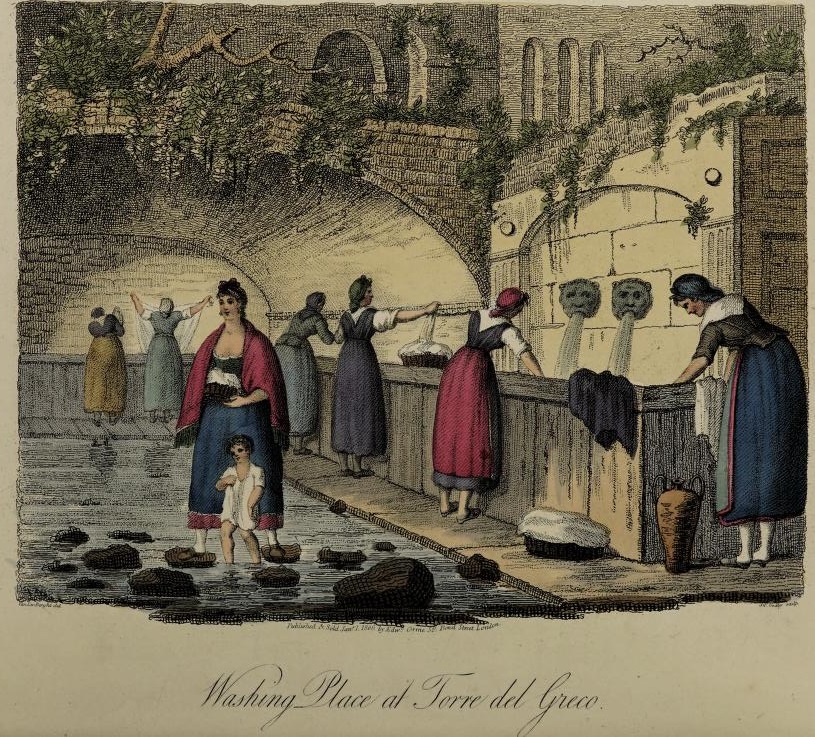
The village near Naples called the Greek’s Tower, was, from the magnificence of it’s buildings, and the number of it’s inhabitants, till lately, a place of considerable importance. Standing at the foot of Vesuvius, the lava, in the terrible eruption of 1794, took it’s direction toward the village, passed over it, destroyed the houses, and, entering into the sea, formed a cape near two miles in length. The name of Tower is of ancient date, as it was one of the seven towers of Naples; but it takes it’s present appellation from a Greek hermit, who settled there, and planted the first cuttings of that vine, which produces the celebrated vin Greco, or Greek wine. It is supposed, that the richness of the fields at the foot of the mountain is owing to the ashes thrown on them by the different eruptions, and to the constant predomination of a sulphurous atmosphere. To this cause is attributed the fine flavour of the wines produced at this place, for here like¬ wise is made the wine called lachrymce Christi.
The subject of the plate is a public fountain, to which the women resort for the purpose of washing their clothes. The linen is first soaked in cold water for twenty-four hours : it is then put into an earthen vessel, resembling a flower-pot, and large in proportion to the quantity to be washed ; over the top of the vessel is spread a piece of strong linen cloth, and wood ashes, from four to six inches deep, are laid uponit. Boiling water is then poured upon the ashes, a gallon at a time. The water is passed through the ashes and the linen from five to seven times, according as the linen is more or less dirty. The linen is then left in the same vessel to cool: the next day it is taken out, rubbed with a small quantity of soft soap, and pressed against the stones of the reservoir where it is washed. When well washed, it is strongly twisted with both hands, to force out the water, and then hung up to dry. In the country people prefer washing in the rivers; but in towns and villages public fountains serve frequently for this purpose; and when not convenient on account of their form, are very often made so and kept in order at the public expense. Almost every house has a washing- place in the yard, built with bricks or stones, but it is troublesome to fill with water, and of course dispensed with where it is possible. The Neapolitan linen is the finest in Italy; and the thread of Gaeta the finest in the world. With this thread are knit such beautiful stockings as to be sold for five guineas a pair. The fountain here represented is built with the lava of Vesuvius. The hair of the women is enclosed in a net, which is the common costume of both sexes at Naples. Ladies of dis¬ tinction, when in their morning dresses, frequently wear nets wrought with gold and silver, which are purchased at a very high price.
LA FONTAINE DE LA TORRE DEL GRECO.
Le village prés de Naples, nomme la Tour du Grec, etoit, par la magnificence de ses batimens, et le nombre de ses habitans, un lien très-considerable. II etoit situe au pied du Mont Vesuve: la lave que ce volcan vomit dans la terrible eruption de 1794, se dirigea du cote de ce village, passa au dessus, detruisit les maisons, et entrant dans la mer, elle forma un promontoire qui a pres de deux milles de long. Le nom de tour qu’il porte est tres ancien, puisque c’etoit une des sept tours de Naples: son nom modernelui vient d’un hermite Grec, qui s’y etablit, et qui le premier y apporta des marcottes de la vignequi produit le fameux vin Greco, ou vin Grec. On pretend que les cendres du Vesuve qui couvrent ce terrain, et fair sulfureux qui y domine, contribuent beau coup a rendre les vins excellens dans les environs de cette montagne. C’est la que l’on fait le lacrima Christi.
Le sujet de cette gravure est une fontaine publique; ou les femmes vont laver leur linge. On le trempe dans l’eau froide pendant vingtquatre heures; apres quoi on l’entasse dans un vase de terre de la forme d’un pot a fleur, aussi grand qu’il le faut, et on le couvre d’une piece de grosse toile, sur laquelle on repand de la cendre de bois, jusqu’ a l’epaisseur de quatre a six pouces. On fait bouillir de l’eau dans une chaudiere, et l’on fait passer toute l’eau bouillante a travers la cendre sur le linge depuis cinq jusqu’ a sept fois, suivant que la linge est plus ou moins sale. On laisse le linge dans ce cuvier jusqu’ a ce qu’il soit refroidi. Le jour suivant on l’en retire et on le lave, en l’employant une petite quantite de savon verd, et en le pressant avec les mains contre les pierres du reservoir ou on le lave: lorsqu’il est bien lave, on le tord de toute sa force pour en exprimer l’eau, apres quoi il n’y a qua l’etendre pour la secher. A la campagne on prefere de laver dans les rivieres. Les fontaines publiques des villes et des villages sont aussi employees a cet usage; et il n’est pas rare de trouver une fontaine publique, comme celle-ci, changee en lavoir et entretenue aux depens de la commune. Il y a des reservoirs pour cet effet dans la cour de presque toutes les maisons, mais il faut les remplir d’eau, et ils sont par consequent moins commodes. La fontaine representee ici est batie de la lave du mont Vesuve. La toile de Naples est la plus belle de toute l’ltalie. Le fil de lin de Gaete est le plus beau que l’on connoisse; fivec ce fil on tricotte des bas si fins qu’on les vend jusqu’ a cinq louis la paire. Les clieveux de ces femmes sont enfermes dans un filet, ce qui est trhs commun a Naples aux deux sexes. Les dames de qualite portent souvent dans leur deshabille de ces filets tissus d’or et d’argent, qui sont d’un grand prix.
Bellissima la descrizione della città distrutta dalle lave del Vesuvio. Interessantissima la procedura del lavaggio dei tessuti; apprezzabili gli aggettivi che l’autore usa nel descrivere la qualità dei tessuti.
THE HERMITAGE OF CAPUA
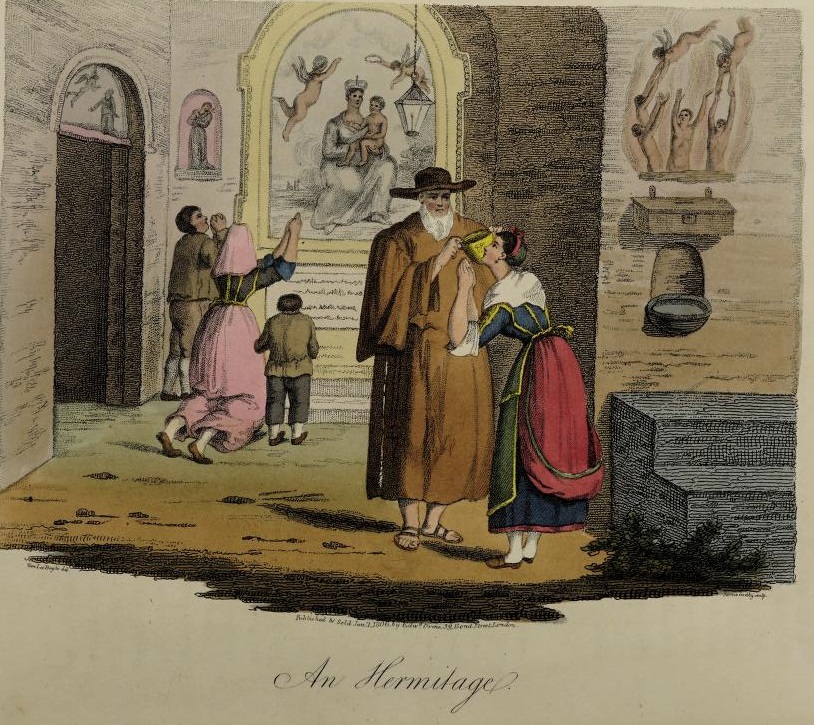
Hermits and their retreats are of considerable antiquity. The anchorets of the Thebaid appear to have been the first, from whom this institution derived it’s origin. They spent their lives in meditation and prayer; and fed upon roots and wild fruits of the desert. The exemplary conduct of those who first withdrew into solitude to avoid the persecutions raging against Christians at that time, the renown of some of them as saints, and their works in di¬ vinity, have given them a distinct and eminent place in the history of the Christian church. The modern hermits are very different: it is true, that they live in the wildest and most recluse spots, but always near some populous village, or convent of monks, to the authority of which they arc generally subject; and by asking charity for what they are or arc not in want of, they live in plenty, and give to the poor of the neighbourhood their superfluities, first selecting the best for their own consumption. The policy of the government has thought proper to place them under the control of the bishop in whose jurisdiction the hermitage is situate. When they have a chapel, the alms and voluntary contribution of the people amount to a considerable sum. The hermitage figured in the plate must be a real mine of gold, as it’s institution, and the holy images, are powerfully calculated to promote the zeal and liberality of the faithful. It stands between Capua and Naples, and is instituted particularly for the purpose of rescuing souls from Purgatory. On the right may be seen the picture of Purgatory, with two angels, each of them taking up a soul from the expiatory flames, and carrying it to Heaven. Under the picture hangs the aim’s box, implying no doubt, that the money which is put into it, and for which masses are celebrated, is the true cause of the liberation of those souls. When these hermits can preach, they represent with eloquence, that the souls still remaining in the fire may probably be those of the father or mother of the persons present; and then there is not one of them, who will not put something into the box, according to his circumstances. Our hermit holds in his hands another powerful spring, to set religious generosity in motion. I mean the bowl, with a holy image painted on the outside. Before he gives it the devotee to kiss, he relates a marvellous tradition or miracle relative to the bowl: and it is well understood, that nobody will dare to kiss such a relic Avithout putting some money into it.
The posture of the old Avoman on her knees, and the tAvo boys, is a lively representation of the mode of praying in those countries by the common people, in Avhich, beside their extravagant gestures, they hold a conversation in an audible voice Avith the holy images, and not unfrequently disco\rer their family secrets, running on as freely as if nobody could overhear them. Before we conclude this article, it may not be amiss to remark the change which has lately taken place in the devotion of the inhabitants of the kingdom of Naples. When the French army entered that city, the generals were convinced of the necessity of conciliating the affection of a brave people, who had liated the French name from the epoch of the Sicilian vespers. They thought that the performance of the liquefaction of St. Januarius’s blood would answer the purpose as a mark of approbation from the saint toward the French; and it might have been presumed, that nothing could be better calculated for this effect. The miracle was accordingly performed; but what was the consequence ? The people, seeing that St. Januarius was partial to the revolution, deserted his worship, which had been for centuries thq palladium of the Neapolitan state, and threw themselves on the protection of St. Anthony of Padua, who had before been only second in favour. We give this as no fiction, but a wellknown fact.
L’HERMITAGE DE CAPOUE
Les hermitages et les hermites sont chune grande antiquite dans la religion chretiennc. Il y a Point de doute que lesanachorhtes delaThebaiden’ayent ete les premiers hermites, aux- quels on doit cette institution. Ils passoient leur vie dans la contemplation ct la pribre ; et se nourrissoient de racines et des fruits sauvages du desert. La vie exemplairc de ces homines fuyant dans ces deserts pour se soustrairc a la persecution allumee contrc les Chretiens, la saintete reconnue de quelques uns d’entre eux, etleurs ouvrages theologiques, leur ont assure un rang distinct et eminent dans l’histoire de l’eglise.
Les hermites modernes sont bien differents. Il est vrai qu’ils habitcnt les lieux les plus sauvages des montagnes, mais toujours pres des villages peuples, ou de couvents, dont souvent ils dependent; et allant a la qu6te de ce dont ils ont ou il ont pas besoin, ils vivent dans babondance, et donnent aux pauvres du voisinage lc surplus, mais jamais ce qu’ils ont demeilleur. La police des bons gouvernements ajuge it propos de les soumettre a bautonte d’un eveque, suivant la situation de l’liermitage. Les aumones, que le people fait a leurs chapelles, lorsq’il en ont une, montent, la fin de hannée, it une sonime considerable.
L’hermitage represente dans cette planche, doit etre une vraie mine d’argent: son institution, et les saintes images qu’on y voit, sont on ne pcut pas plus propres it exciter le zele et la generosite des fidelles. Il est situe entre Capoueet Naples; et on y prie particulierement pour la delivrance des ames du purgatoire. On voit it la droite le tableau du purgatoire avec deux anges, qui retirent chacun une ame du feu expiatoire. La boite des aumones est placee au dessous du tableau, et semble direce sont les aumones, que l’on met ici dedans, et avec lesquelles on fait celebrer des messes, qui effacent les peches de ceux qui sont dans le purgatoire. Lorsque ces hermites sont capables de precher, ils representent avec eloquence, que les ames qui n’ont point d’ange pour les delivrer peuvent etre celles du p£re ou de la mere de ceux qui ecoutent le sermon; et alors il n’y en a pas un cpii ne s’empresse de mettre dans la boite toutce que sa fortune lui permet de donner. L’hermite qu’on voit ici tientdans ses mains une autre ressource pour exciter une devotion genereuse. C’est une ecuelle de faience avec unesainte image peinte en dehors. Avant de la donner abaiser, on fait toujours preceder le recit merveilleux d’une tradition, oude cjuelcjue miracle relatif it cette coupe: bien entendu que bon ne baise pas de telles reliques sans y mettre dedans au moins la plus petite monnoie courante. La situation de la bonne femme, et des deux jeunes garfons cpii prient dans des positions dilferentes, exprime vivement lamaniere de prier du baspeuple de ces contrees. Outre leurs gestcs singuliers, ils font avec la sainte image une conversation a haute voix, qui met souvent au jour des secrets de famille, et ils vont leur train sans facon, comme s il ny avoit personne pour les entendre.
THE FOUNTAIN OF CAPUA
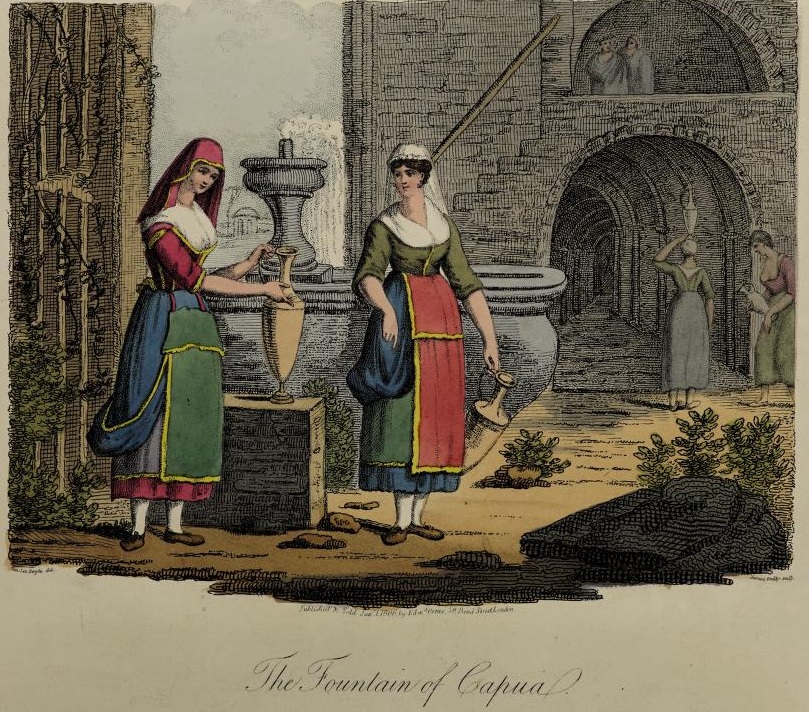
Italy is perhaps furnished with more conveniencies for the public service than any other country in Europe. We are now considering only the public fountains, though every house is provided with a well of very good water. To have a perfect idea of the magnificence of these, which in many towns conduce very little to their embellishment, it is necessary to have been at Rome, where the different fountains pour forth so much water, that if it were to float on the surface of the earth, it would inundate the whole city in the space of twentyfour hours. Capua, one of the most ancient towns of Italy, is amply supplied with establishments for the public welfare. The present city is modem, the site of ancient Capua being about a mile distant, where considerable ruins are still to be seen in the village of Santa Maria, between the rivers Yolturno and Clanio. The Romans, in order to punish Capua for having sided with Hannibal, who had promised to make it the capital of Italy, took it after a long siege, and delivered it up to the soldiery to pillage; the lower class of the inhabitants were made slaves, and sold by auction, the patricians were dispersed, and the senators whipped and afterward beheaded. Genseric, king of the Vandals, completed the destruction of this city in the year 455. It is remarkable, as may be seen in the plate, that the form of the pitchers is the same now, as was anciently given to this kind of earthen ware. The kingdom of the Two Sicilies has preserved it’s ancient customs better than any other country of Italy; and the attentive antiquary will observe them in many instances in the lower class of the people. The headdress of the women resembles very much that we see in ancient busts, the hair being plaited or curled on each side of the forehead. The head is covered with a piece of red cloth laced with gold, or with a kind of linen veil falling backward. The gown and apron are bordered with different coloured ribands, and as the shape and fashion ot the dresses change but little, all the taste consists in the brilliancy and distribution ot the colours.
LA FONTAINE DE CAPOUE
Tout ce qui a pour but l’utilite publique esten Italie mieux entendu, et plus magnifiquement execute, que dans aucune autre partie de bEurope. II ne s’agit ici que des fontaines publics, qui fournissent de beau de source, quoique toutes les maisons aient un puits de tr£s- bonne eau. Pour avoir une juste idee de la magnificence de ces etablissemens publics, qui ne sont pas toujours faits pour rembellissement d’une ville, il faut avoir ete a Rome, oil les differeutes fontaines versent tant d’eau, que Ton a calcule que si cette eau s’arr&toit sur la surface de la terre, la ville en seroit entierement couverte en vingtquatre hcures. Capoue qui est une des plus anciennes et des plus celbbres villes de bltalie, ne manque pas de ces etablissemens publics. La presente Capoue est moderne, car bancienne ville est situee a pres de demi-lieue de distance, et l’on voit encore des restes considerables au bourg de Sainte Marie, entre le Volturne et le Clanio. Les Romains, pour la punir d’avoir pris parti pour Annibal, qui avoit promis d’en faire la capitale de bltalie, l’ajant prise a la suite cbun long siege, cinq ans aprks leur deroute a Cannes, la saccagerent; le bas peuple fut fait esclave, etvendu al’encan; les patriciens disperses, les senateurs fouettes et decapites. Genseric, roi des Vandales, acheva de la detruire l’an 455. On voit par cette planche, que la forme des cruches est la meme que celle qu’on avoit don- nee anciennement a cette espece de vases de terre. Le royaume des Deux Siciles a mieux conserve les usages anciens quaucun autre pays d’ltalie; et l’antiquaire attentif en re- trouvera beaucoup dans le bas peuple. La coiffure des femmes ressemble beaucoup a celle que Ton remarque dans les statues et les bustes anciens, et qui consiste en tresses qui tombent en boucles de chaque cote du front sur les tempes. La t&te est couverte d’un drap rouge galonne en or, ou d’un morceau de toile qui tombe en arriere comme un voile. La robe et le tablier sont bordes de rubans de differentes couleurs, toutes tranchantes a la mode des Napolitains, car comme la facon de tailler les habits ne change guere, toute l’elegance consiste a faire ressortir les differentes couleurs.
_________________________________________________________________________________
Grazie ad Armando Polito per aver segnalato il testo e per averci consentito l’apertura a questa preziosa raccolta di immagini e descrizioni.
I testi e le immagini sono tratte da
ITALIAN SCENERY, REPRESENTING THE MANNERS, CUSTOMS, AND AMUSEMENTS OF THE DIFFERENT STATES OF ITALY. BY JAMES GODBY, FROM ORIGINAL DRAWINGS BY P. VAN LERBERGHI; THE NARRATIVE BY M. BUONAIUTI.
Londra 1806
https://archive.org/details/b30450238/page/n7